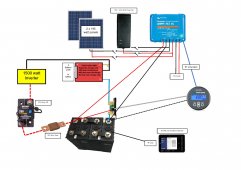Maybe there should be a separate forum just for RV's, campers and caravans etc. There is a lot of chat here talking about amperages WAY higher than I would ever want or need, 100 amps from CC! in an RV?, I don't think so Tim. So anyways my system seems to be chuffing along nicely, haven't had any issues in the last 12 months.
In relation to the discussion about LiFePO4 cells holding up in rough conditions I would just say this, there are currently (it appears) about half a millions RV's of different types coming straight from the factory with lithium batteries, bashing their way around the Australian Outback. Try 600 kilometres of bad washboard corrugations at about 80 Klms an hour! (not my idea of fun). That will shake the sh#t out of anything, and often destroys suspensions and tyres, haven't heard a peep from anyone about battery damage to date.
Safe travels everyone.
My system:
View attachment 66804





